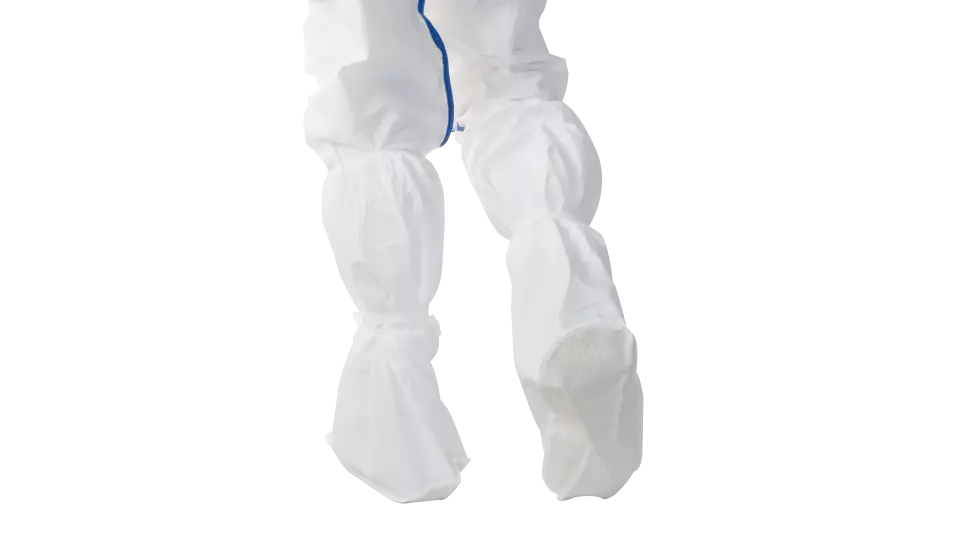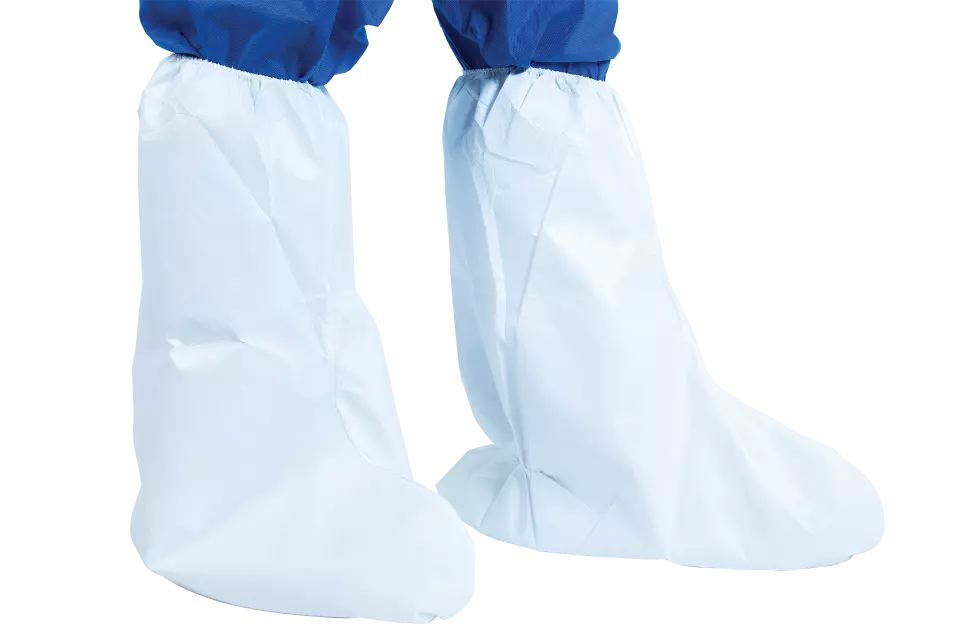WeeSafe WeePro Overboot with Anti Slip Sole Type PB 6, S/M, White
Medicom
visit storeProduct description
Professional overboot designed for critical environment protection featuring antistatic properties and chemical resistance. The boot incorporates a very low-linting fabric construction with a thick PVC anti-slip sole, providing comprehensive protection up to knee height. Enhanced with elastic tightening systems and antistatic treatment, it offers reliable protection in controlled environments.
Product Features:
- Very low-linting fabric preventing contamination in controlled environments
- Thick PVC sole with anti-slip properties for dry and wet surfaces
- Elastic tightening under knee with calf-level securing tie
- 50 CM boot height for knee-level protection
- Antistatic treated material for electrostatic charge dissipation
Technical Details:
- Type PB 6 protection classification
- Chemical protection capabilities
- Antistatic properties (EN 1149-5)
- Biological protection (EN 14126)
Recommended Applications:
- Protection against low-concentration chemicals
- Protection from powders, adhesives, and fiberglass
- Protection from solvents and paints
Standards:
- EU Regulation 2016/425 compliant
- PPE Category Cat. III
- CE certified
- EN 1149-5
- EN 14126
The material composition of the sole, affecting durability, comfort, grip, and performance characteristics of the shoe accessory.
Describes the bottom surface design and protective features, such as slip resistance, puncture protection, or shock absorption capabilities.
The visual appearance of the accessory, affecting style coordination, workplace compliance, and visibility requirements.
Determines the visual appearance of the sole, affecting how well it matches or complements your existing footwear and personal style preferences.
The substance or fabric used to make the shoe accessory, affecting durability, comfort, performance, and care requirements.
- Chemical Resistance
- Slip Resistant
- Shoe Protection
- Electrical Protection
Request a free sample
Test first and buy later. Visit any product page to request your free sample.
Standards and labels
Chemical protective clothing, like coveralls and suits, with the EN ISO 13982-1:2004 rating are tested for resistance against penetration by airborne solid particles and for robust seam integrity. This ensures the clothing provides reliable full-body protection from hazardous dusts and fine dry chemicals.
Test results
Airborne Solid Particle Protection Type 5This full-body suit protects you from hazardous airborne solid particles like dust and fibres. It's ideal for tasks such as asbestos removal, pharmaceutical work, or any job where you are exposed to harmful dry particulates.
Protective clothing, such as coveralls and aprons, with the EN 13034:2005 rating are tested for limited protection against light spray, liquid aerosols, or low-volume splashes of liquid chemicals. This means the clothing provides a barrier against minor chemical exposure, allowing you time to safely remove it before chemicals penetrate.
Test results
Liquid Chemical Protection Type 6 PBThis garment provides partial body protection against minor chemical risks. It is designed to shield you from light sprays, small splashes, and liquid aerosols where a full chemical barrier isn't needed. Ideal for tasks like maintenance or cleaning.
Protective clothing materials with the EN ISO 6530:2005 rating are tested for their resistance to penetration, absorption, and repellency against liquid chemicals. This means the clothing effectively guards against splashes or light sprays of hazardous liquids, ensuring your safety in environments where chemical contact is a risk.
Test results
Liquid Penetration Class 3This garment provides a high level of protection against liquid chemicals. It resists penetration from small splashes and low-pressure sprays of specific chemicals like acids and alkalis, with less than 1% of the liquid getting through.
Protective clothing with the EN 1149-5:2008 rating is tested for its ability to safely dissipate electrostatic charges and prevent sparks. This protects wearers in environments where flammable gases, liquids, or dust could create an explosive atmosphere. It reduces the risk of accidental fires or explosions from static discharge.
Test results
Material Performance TestedThis garment's material is tested to reduce static electricity buildup. It helps prevent sparks that could cause a fire or explosion in certain work environments, keeping you safer around flammable materials or sensitive electronics.
Protective clothing and coveralls with the EN 14126:2003 rating are tested for resistance against penetration by infective agents like bacteria, viruses, and contaminated liquids and aerosols. This means the material provides a reliable barrier, helping to protect you from biological hazards and prevent the spread of germs.
Protective clothing with the EN 13688:2013 rating are tested for general requirements like ergonomics, harmlessness, accurate sizing, durability after cleaning, and clear labeling. This ensures the clothing is safe, comfortable, fits well, and provides reliable, long-lasting protection with clear user instructions.
Protective clothing with the EN 1073-2:2002 rating are tested for protection against particulate radioactive contamination. This ensures the clothing effectively minimizes the inward leakage of hazardous radioactive particles to keep you safe.
Protective clothing with the EN 530:1994 rating is tested for its abrasion resistance. This means the material has been evaluated for its ability to withstand rubbing and wear, offering enhanced durability and protection for the wearer.
Protective clothing and materials with the EN 863:1995 rating are tested for puncture resistance. This measures the maximum force needed to push a sharp spike through the material, helping you choose clothing that protects against penetration by sharp objects.
Textile fabrics with the EN ISO 13934-1:1999 rating are tested for their tensile strength and how much they stretch before breaking. This ensures the fabric's durability and resistance to tearing, leading to longer-lasting products.
Rubber- or plastics-coated fabric products with the EN ISO 7854:1997 rating are tested for their resistance to damage from repeated flexing. This means the material has been assessed for how well it withstands bending and crumpling over time, indicating its durability and ability to maintain its integrity with use.
Nonwoven fabrics and products with the EN ISO 9073-4:2021 rating are tested for their tear resistance using a specific trapezoid method. This ensures that the material can withstand tearing forces, providing consumers with more durable and long-lasting products.
CE Marking is a label that shows a product meets certain safety and environmental standards set by the European Union. To get the CE Marking, a company must test and certify their product meets these standards. CE Marking is required for many products sold in the EU, including electronics, machinery, toys and medical devices. It helps ensure that products are safe for consumers and the environment, and allows for easy trade within the EU.
PPE stands for "personal protective equipment." PPE Category 3 refers to equipment that is complex and provide the highest level of protection such as powered respirators, SCBA, and full body suits. In Europe, PPE Category 3 must meet certain safety standards set by the European Union, which means that it must be designed and manufactured to protect the user without causing harm. Companies that make or sell PPE must prove that it meets these standards. They also must have a quality management system in place, have to be audited regularly by a notified body and have to have a technical documentation.
Medicom delivery terms
Free delivery when you order more than 150,00 € from Medicom
Supplier shipping fee 5,00 €
Brand minimum 200,00 €
Price available on request
Shipping fee is 5,00 € for orders under 150,00 €
A carton contains 1 package (300 pieces)
Need larger quantities?
Other products you may like
Recently viewed
Need help?
Get help from our experts
Other products you may like
Similar products you may like
Autonomous sourcing platform
The most efficient way to source and order supplies for your operations
Sourcing
Ordering
List products you’re looking for and we’ll find the best products and prices for you – all for free.
Need help?
Get help from our experts




